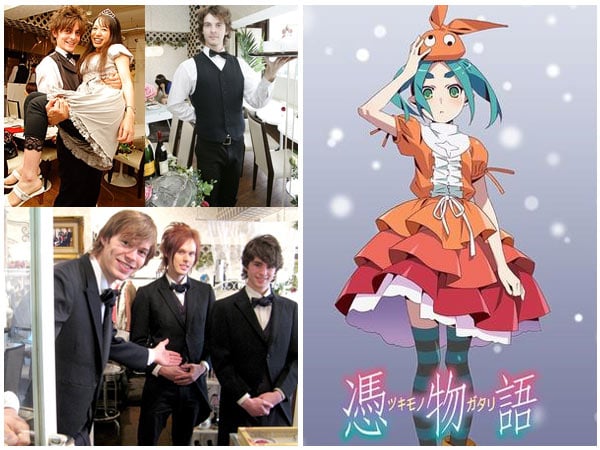
Recently I started watching the latest Bakemonogatari sequel, called Tsukimonogatari, which is a great series for fans of both high quality voice actor performances as well as anime characters tilting their heads. If you’re not familiar with the series, it’s basically about a half vampire named Koyomi Araragi who interacts with different girls, each of whom becomes possessed by an animal spirit (crab, snail, cat, etc), requiring Araragi to help them. The show is a good example of the way anime creators use very specific modes of speaking to make their characters come alive. Sometimes this is done in subtle ways, for example the slightly quirky way most characters speak, always using the too-formal word けれど keredo (meaning “but”) instead of the more casual けど kedo that’s commonly used. Several characters in the show use stylized dialects of Japanese, like Kagenui’s luxurious Kyoto accent, or the way Shinobu speaks in a dialect reminiscent of samurai period dramas, since she is a 500 year old vampire and all that. (Aside: Yoda speaks with the same generic Edo Period dialect as Shinobu in dubbed Star Wars films, which I always thought was kind of a shame, since his English mode of speaking is so much deeper and more interesting.) Remember that, while watching anime is a fun way to plug into Japanese popular culture, anyone interested in studying Japanese should avoid learning too much this way. Don’t go and learn Japanese from Fist of the North manga like I did…trust me, you don’t want to do that.
Japan’s maid cafes are famous all around the world as a place you can have a cup of coffee and get a heart drawn in ketchup over your omurice. The first maid cafe was the Cure Maid Cafe which opened in 2001 in Akihabara, and it was an immediate success, forever cementing Akiba’s association with otaku culture. Maid cafes are an extremely competitive industry, and the companies have to always be inventing the next version, which has led to the creation of shrine maiden cafes, twintail imouto cafes, EGL maid cafes, and at least one tsundere cafe in which the girls verbally abuse customers then act sweet and loving as they leave. With the rise of female otaku fandom, one shop in Shibuya called the Butler’s Cafe is mixing things up a bit. Instead of the traditional model, female customers are greeted by sharply-dressed butlers from countries like France, Britain or Sweden, who escort them to tables and treat them like princesses while they take their orders. Customers can purchase extra services, such as having the handsome foreign butlers stare into their eyes for ten seconds, or お姫様抱っこ ohime-sama dakko, being picked up and carried like a princess, which is apparently something Japanese women don’t get enough of in their lives. For special events, the cafe does a “Cinderella Time” performance in which a glass slipper is brought out and customers are allowed to try it on, to see if they can become a real princess.
We had a hectic Holiday season, with hundreds of orders being processed by the hardworking J-List staff per day. In all the confusion, we didn’t notice that our popular Facebook page had crossed 200,000 ‘likes.’ To commemorate this milestone, and to thank everyone for participating on our Facebook page (and Twitter, and Tumblr), we’re having one of our 10% off anything coupons through the end of Tuesday, California time. Just enter 200KTHANKS at the shopping cart page as you check out. No minimum, but you can only use it once, so make it count!
Valentine’s Day is right around the corner, and you might have noticed some really amazing new chocolates and other snacks being posted to J-List’s snack pages. We’ve got a great lineup this year, from Rilakkuma chocolates to Hello Kitty-shaped chocolates to Attack on Titan chocolates so you can build your love-shrine to Levi. Browse our newest snacks from Japan, or sort the products by customer ranking.

















